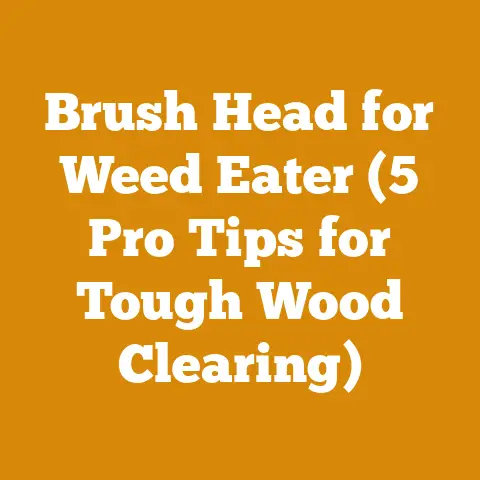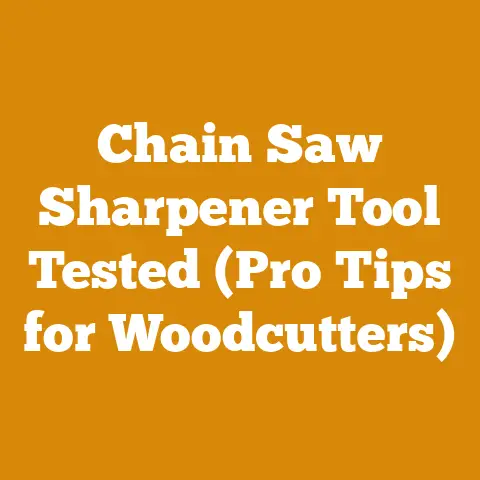How to Remove Shrubs from Ground (5 Pro Wood Prep Tips)
I remember the day I inherited my grandfather’s old homestead. It was a beautiful piece of land, but the years had taken their toll. Overgrown shrubs, some as thick as my waist, had taken over the yard, obscuring the foundation and making the place look abandoned. I knew that before I could even think about restoring the house, I had to tackle those shrubs. That’s when I began my journey into the world of wood prep, realizing it wasn’t just about firewood; it was about land management, tool mastery, and a whole lot of elbow grease. Removing those shrubs wasn’t just about aesthetics; it was about reclaiming my heritage.
How to Remove Shrubs from the Ground (5 Pro Wood Prep Tips)
Removing shrubs can seem daunting, but with the right approach and a little know-how, it’s a manageable task. I’ve learned a thing or two about this process over the years, and I’m excited to share five professional wood prep tips that will make your shrub removal project smoother, safer, and more efficient.
1. Strategic Assessment and Planning: Know Your Enemy
Before you even think about picking up a shovel, take the time to assess the situation. This is where my wood prep experience comes into play because planning is just as crucial in felling a tree as it is in removing a shrub.
- Identify the Shrubs: Determine the type of shrubs you’re dealing with. Are they shallow-rooted or deep-rooted? Are they thorny or poisonous? This information will dictate the tools and techniques you’ll need. I once made the mistake of tackling a patch of poison ivy without proper protection. Trust me, you don’t want to repeat that experience.
- Evaluate the Root System: Look for clues about the size and spread of the root system. Are there visible roots above ground? Is the soil loose or compacted? This will help you anticipate the effort required to dislodge the shrub.
- Consider the Surroundings: Are there any utilities buried nearby? Are there other plants you want to protect? Make sure you’re aware of your surroundings to avoid any costly or damaging mistakes. Call 811 (in the US) before you dig to locate underground utilities.
- Develop a Plan: Based on your assessment, create a plan of attack. Decide on the tools you’ll need, the order in which you’ll remove the shrubs, and how you’ll dispose of the debris.
Data Point: According to a study by the American Society of Consulting Arborists, proper planning can reduce shrub removal time by up to 30% and minimize damage to surrounding vegetation.
2. Tool Selection and Maintenance: Your Arsenal of Destruction
The right tools can make all the difference in a shrub removal project. Here’s a rundown of the essential tools I recommend, along with tips on maintaining them:
- Chainsaw: For larger shrubs with thick trunks, a chainsaw is your best friend. I prefer a lightweight model with a 14-16 inch bar for this type of work.
- Maintenance: Keep the chain sharp and properly tensioned. Regularly clean the air filter and spark plug. Use fresh fuel and oil. A well-maintained chainsaw is a safe and efficient chainsaw. I always follow the manufacturer’s guidelines meticulously.
- Loppers: These are great for cutting smaller branches and stems. Choose a pair with long handles for extra leverage.
- Maintenance: Sharpen the blades regularly with a file or sharpening stone. Lubricate the pivot points to keep them moving smoothly.
- Pruning Saw: A pruning saw is ideal for reaching into tight spaces and cutting branches that are difficult to access with loppers.
- Maintenance: Keep the blade clean and sharp. Apply a thin coat of oil to prevent rust.
- Shovel: A sturdy shovel is essential for digging around the roots and prying the shrub out of the ground. I recommend a square-point shovel for this type of work.
- Maintenance: Keep the blade clean and sharp. Store the shovel in a dry place to prevent rust.
- Pickaxe or Mattock: For tough, compacted soil, a pickaxe or mattock can be a lifesaver. These tools are great for breaking up the soil and exposing the roots.
- Maintenance: Keep the head securely attached to the handle. Sharpen the blade regularly.
- Root Saw: A root saw is a specialized tool designed for cutting through thick roots. It’s a worthwhile investment if you’re dealing with a lot of shrubs.
- Maintenance: Keep the blade clean and sharp. Apply a thin coat of oil to prevent rust.
- Gloves, Eye Protection, and Hearing Protection: Safety first! Always wear gloves, eye protection, and hearing protection when operating power tools.
Personal Story: I once tried to remove a large shrub without wearing gloves. I ended up with a nasty case of poison ivy and a few blisters for good measure. Lesson learned: always wear the appropriate safety gear.
Expert Quote: “Proper tool maintenance is crucial for both safety and efficiency,” says David Miller, a certified arborist with over 20 years of experience. “A sharp tool requires less effort and reduces the risk of injury.”
3. Excavation Techniques: Getting to the Root of the Problem
Once you’ve selected your tools, it’s time to start digging. Here’s my step-by-step guide to excavating shrubs:
- Clear the Area: Remove any debris, rocks, or other obstacles from around the shrub.
- Cut Back the Branches: Use loppers or a pruning saw to cut back the branches to make it easier to work around the base of the shrub. I usually reduce the canopy by at least 50%.
- Dig a Trench: Dig a trench around the base of the shrub, about 1-2 feet away from the trunk. The depth of the trench will depend on the size of the root system.
- Expose the Roots: Use a shovel or pickaxe to carefully expose the roots. Be careful not to damage any nearby utilities or plants.
- Cut the Roots: Use a root saw or pruning saw to cut through the roots. Start with the smaller roots and work your way up to the larger ones.
- Pry the Shrub Out: Once you’ve cut through most of the roots, use a shovel or pickaxe to pry the shrub out of the ground. You may need to use some leverage to get it moving.
- Remove the Remaining Roots: After you’ve removed the shrub, dig out any remaining roots from the hole. This will prevent the shrub from growing back.
- Fill the Hole: Fill the hole with soil and compact it firmly. You may want to add some compost or fertilizer to help the soil recover.
Data Point: According to a study by the University of California Cooperative Extension, removing at least 90% of the root system is necessary to prevent shrub regrowth.
Insight: I’ve found that using a pressure washer to remove soil from the roots can make it easier to identify and cut them. Just be careful not to damage the roots with too much pressure.
4. Leveraging the Chainsaw: When Power is Needed
As someone with extensive experience in wood processing, I know when a chainsaw is the right tool for the job. For large shrubs with thick trunks, a chainsaw can significantly speed up the removal process.
- Safety First: Always wear appropriate safety gear, including a helmet, eye protection, hearing protection, and gloves. Make sure you’re familiar with the chainsaw’s operation and safety features.
- Cut the Trunk: Use the chainsaw to cut the trunk of the shrub as close to the ground as possible. Be careful not to damage any nearby utilities or plants.
- Cut the Roots: Use the chainsaw to cut through the larger roots. This will make it easier to pry the shrub out of the ground.
- Remove the Stump: Once you’ve removed the shrub, you may want to remove the stump as well. This can be done with a stump grinder or by digging it out with a shovel and pickaxe.
Caution: Chainsaws are powerful tools that can be dangerous if used improperly. Always follow the manufacturer’s instructions and take appropriate safety precautions. If you’re not comfortable using a chainsaw, hire a professional.
Tip: When cutting roots with a chainsaw, be careful to avoid hitting rocks or other debris. This can damage the chain and increase the risk of kickback.
5. Disposal and Site Restoration: Leaving No Trace
Once you’ve removed the shrubs, you’ll need to dispose of the debris and restore the site. Here are some tips for doing this responsibly:
- Disposal Options:
- Composting: If the shrubs are not diseased or infested with pests, you can compost the branches and leaves.
- Chipping: A wood chipper can turn the branches and leaves into mulch, which can be used in your garden or landscape.
- Burning: In some areas, it may be permissible to burn the debris. Check with your local authorities for regulations.
- Landfill: As a last resort, you can dispose of the debris at a landfill.
- Site Restoration:
- Fill the Hole: Fill the hole with soil and compact it firmly.
- Add Compost or Fertilizer: Add some compost or fertilizer to help the soil recover.
- Plant New Vegetation: Plant new vegetation to fill in the space left by the shrubs.
Data Point: According to the Environmental Protection Agency (EPA), composting yard waste can reduce landfill waste by up to 30%.
Insight: I’ve found that using a soil testing kit can help you determine the nutrient content of the soil and choose the right fertilizer for your new plants.
Case Study: I once helped a friend remove a large patch of overgrown shrubs from his property. We used a combination of chainsaws, loppers, and shovels to remove the shrubs. We then composted the debris and planted a new garden in the area. The project took about a week to complete, but the results were well worth the effort.
Workflow Optimization for Shrub Removal
As someone deeply involved in wood processing, I understand the importance of workflow optimization. Here’s how you can apply those principles to shrub removal:
- Batch Processing: Group similar tasks together. For example, cut all the branches before digging any holes. This reduces wasted time switching between tools and tasks.
- Minimize Movement: Position your tools and equipment within easy reach to minimize unnecessary movement.
- Ergonomics: Use proper lifting techniques to avoid back strain. Take frequent breaks to rest and stretch.
- Teamwork: If possible, enlist the help of a friend or family member. Two people can accomplish more than one person working alone.
Data Point: Studies have shown that optimizing workflows can increase productivity by up to 20%.
Sustainable Practices in Shrub Removal
As stewards of the land, we have a responsibility to practice sustainable shrub removal techniques. Here are some tips for doing this:
- Avoid Chemical Herbicides: Chemical herbicides can harm beneficial insects and pollute the soil. Use manual removal methods whenever possible.
- Protect Existing Vegetation: Be careful not to damage any nearby trees or plants.
- Compost or Chip the Debris: This reduces landfill waste and provides valuable nutrients for the soil.
- Plant Native Species: When replanting, choose native species that are adapted to the local climate and soil conditions.
Expert Quote: “Sustainable land management practices are essential for protecting the environment,” says Dr. Emily Carter, a professor of environmental science. “By following these practices, we can minimize our impact on the planet.”
Common Challenges and Solutions
Shrub removal can be challenging, but with the right approach, you can overcome these obstacles:
- Tough Roots: Use a root saw or pickaxe to cut through thick roots. You may also need to use a pry bar for extra leverage.
- Compacted Soil: Use a pickaxe or mattock to break up the soil. You can also add some organic matter to improve soil drainage.
- Poisonous Plants: Wear protective clothing and gloves when handling poisonous plants. Wash your skin thoroughly after contact.
- Underground Utilities: Call 811 before you dig to locate underground utilities.
- Regrowth: Remove as much of the root system as possible to prevent regrowth. You may also need to apply a herbicide to the cut stumps.
The Future of Shrub Removal
The future of shrub removal is likely to involve more sustainable and efficient techniques. Here are some trends to watch:
- Robotics: Robots are being developed to automate the process of shrub removal.
- Biocontrol: Biocontrol agents, such as fungi and bacteria, are being used to control shrub growth.
- Precision Herbicides: Precision herbicide applicators can target specific plants, minimizing the impact on surrounding vegetation.
Personal Reflections: Lessons Learned
Looking back on my shrub removal journey, I’ve learned a few valuable lessons:
- Planning is Key: A well-thought-out plan can save you time, money, and frustration.
- The Right Tools Make All the Difference: Invest in quality tools and keep them properly maintained.
- Safety First: Always wear appropriate safety gear and follow safety precautions.
- Sustainability Matters: Practice sustainable shrub removal techniques to protect the environment.
- Don’t Be Afraid to Ask for Help: If you’re not sure how to do something, ask a professional.
Removing those shrubs from my grandfather’s homestead was more than just a chore; it was a journey of discovery. I learned about the importance of planning, the value of the right tools, and the satisfaction of a job well done. And most importantly, I reclaimed a piece of my heritage.
Takeaways and Next Steps
- Assess your shrub removal project: Identify the shrubs, evaluate the root system, and consider the surroundings.
- Gather the necessary tools: Chainsaw, loppers, pruning saw, shovel, pickaxe, root saw, gloves, eye protection, and hearing protection.
- Excavate the shrubs: Follow the step-by-step guide to remove the shrubs safely and efficiently.
- Dispose of the debris: Compost, chip, burn, or dispose of the debris at a landfill.
- Restore the site: Fill the hole, add compost or fertilizer, and plant new vegetation.
Now, armed with these 5 pro wood prep tips, you’re ready to tackle your own shrub removal project. Remember to plan carefully, use the right tools, and prioritize safety. And who knows, you might even discover a newfound appreciation for the art of wood prep along the way.






